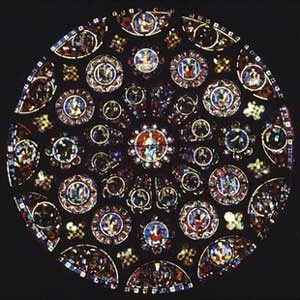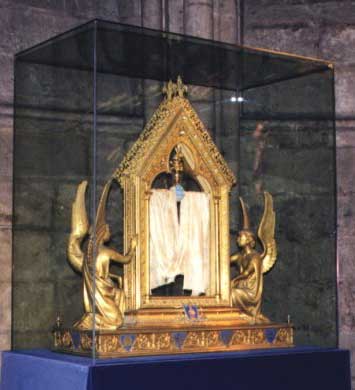 |
 |
 |
 |
 |
 |
 |
 |
 |
 |
 |
   |
2. CHARTRES - This twelfth-century Gothic church a few miles west of Paris was built on an earlier, pre-Christian religious site, and became an important pilgrimage goal for medieval pilgrims. Chartres was built on the site of a Roman Temple called Autricum itself built over a Druid Temple where the Black Madonna was venerated from pre-Christian times. Beneath the cathedral is a crypt, originally a sacred grotto and healing well of the Druids. The astrological and pre-Christian origins became incorporated into the symbolism of the cathedral. The stained glass windows at Chartres are renowned for their richness and beauty. The more wall space was opened up and simplified by high Gothic design, the more space was available to be decorated with the ornate stained glass masterpieces, which still exist today. The famous Blue Virgin window completed around 1150 and more than 150 early 13th century windows make Chartres one of the most complete collections of medieval stained glass still in existence. The beauty and stories told through the stained glass reflects the culture and lives of the middle ages, and were used to teach pilgrims and the illiterate religious piety and stories. 2. CHARTRES - The Labyrinth A labyrinth with an eleven-circuit design divided into four quadrants was often found in Gothic Cathedrals, but over time many of these eleven-circuit designs were destroyed or intentionally removed. The most famous of these remaining is at Chartres. The labyrinth at Chartres was built around 1200 and is laid into the floor in a style sometimes referred to as a pavement maze. The original centerpiece has been removed and other areas of the labyrinth have been restored. One of the most famous aspects of Chartres cathedral is the spectacular rose window over the great west doors. It has the same dimensions as the labyrinth and is exactly the same distance up the west wall as the labyrinth is laterally from the cathedral's main entrance below the window. An imaginary hinge located where the doors and floor intersect would, if closed, place the rose window directly on top of the labyrinth, thus the sparkling, colored light of the window and the darkness of the labyrinthine pilgrimage are combined. This labyrinth is designed to be walked, the walker meanders through each of the four quadrants several times before reaching the goal, but is less frequently used today. In the past it could be walked as a pilgrimage and/or for repentance. When used for repentance the pilgrims would walk on their knees. Sometimes this would serve as a substitute for an actual pilgrimage to Jerusalem and the labyrinth came to be called the "Chemin de Jerusalem." The four arms of the cross are clearly evident. At the center is a rosette design that has a rich symbolic value. This center, with its petals, is the symbol of Mary, Mother of God, the Holy Spirit and along with its Eastern counter part, the lotus, is almost universally considered a symbol of enlightenment. A few walkers had wept as they walked. Many visitors didn't even notice the floor pattern. M and W raced to enlightenment. CHARTRES - The Cloth of the Madonna Important relics are a large aspect of a cathedral's fame. Each relic was prominently placed in elaborate reliquary where worshippers would file by and see the precious object faintly through a small glass window. The actual veil of the Blessed Virgin Mary resided in a church in Aix-la-Chapelle until it was brought to Chartres by Charlemagne's grandson, Emperor Charles the Bald, in 876. The cathedral of Notre Dame de Chartres was enlarged specifically to house this sacred relic of Our Lady. There are many miraculous accounts regarding this relic. Sometimes the veil has been referred to as the "tunic", or the "chemise", of the Blessed Virgin, which has created some confusion as to the nature of the piece of clothing. It is off-white in color and rectangular in shape, a single piece of raw silk, and not a shirt or tunic. It has been authenticated as silk of Eastern origins, originating from the time of Our Lady. During the French Revolution, the veil was deliberately divided into parts to ensure its safety. The cathedral retains the largest portion to this day, and has since recovered another major piece. The others, however, have been fragmented and distributed worldwide. "One God." D had been looking at the secular backgrounds of the stonecarvings, when he came to the relic. Some tourists, a few more women weeping, K and M and W elsewhere in the cathedral. |

